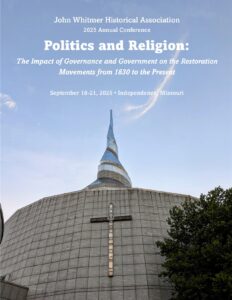“The Past and Future of the Prophetic Monarchy in the Latter Day Saint Tradition”
As the United Kingdom and the Commonwealth realms marked the end of an era with the death of their longest reigning monarch, Queen Elizabeth II and the accession of her less popular son King Charles III, they have reflected on the state and future of their constitutional monarchy. John Hamer will look at the state of the Latter Day Saint tradition churches through the prism of monarchy.
Although James Strang is perhaps the Mormon who is most famous for crowning himself king, he did so in emulation of Joseph Smith Jr, who restored “the kingdom of God on earth” in his final year and was anointed its king in a secret ceremony of the Council of Fifty. His assassination shortly thereafter came at a time when his heir apparent, Joseph Smith III, was still an 11-year-old boy. Brigham Young successfully established the Twelve as a kind of “regency council” and then three years later in 1847 took the throne for himself. Young’s reign is best understood through the prism of monarchy as that of a “usurper”: a monarch who seized the throne and is forced to act out of awareness of his own lack of legitimacy. (Usurpers are not always bad monarchs: for every Stephen, there is a William and Mary, for every Richard III, there is a Henry VII.)
When Joseph Smith III came of age and was anointed prophet and president of a New Organization of the church (with only a few hundred loyalist members at the outset), he became a “pretender” to the throne. Faced with the true heir, Brigham Young and his loyalists were forced to create new arguments for his legitimacy (retrojecting a vision of the mantle descending on him back to 1844). Fortunately, from his perspective, Joseph Smith III was far more interested in (falsely) clearing his father’s reputation than in helping the Latter Day Saint people escape Young’s rule. Having fended off the pretender, Young attempted to establish his own dynasty with Brigham Young Jr. as his successor. However, John Taylor, the president of the Utah Quorum of Twelve successfully outmaneuvered potential claimants to the throne from both the Young and Smith families (the latter in the form of Hyrum Smith’s son, Joseph F. Smith, who many hoped would succeed Brigham Young). Succession of the President of the Twelve, retroactively legitimized Brigham Young’s own claims and locked the Utah-based Church of Jesus Christ of Latter-day Saints into a system of increasingly geriatric oligarchy. No changes in the system are possible, as each successive monarch comes to prophetic role too aged to institute meaningful reform.
Meanwhile, Joseph Smith III succeeded in regathering many of the Saints scattered among the diverse Restoration factions of the 1840s and 50s, creating a new kingdom in the Midwest. While William Smith had (self-servingly) promoted lineal succession to the prophetic monarchy, Joseph Smith III emphasized his appointment by his predecessor as the source of his legitimacy (citing D&C 43). Nevertheless, he appointed his eldest son, Frederick Madison Smith, as his successor, cementing a tradition of lineal succession to the prophetic monarchy in the RLDS tradition that would last until the end of the 20th century.
In 1996, the last Smith prophet, Wallace B. Smith, appointed W. Grant McMurray as his successor (D&C 160), beginning a new chapter in the prophetic monarchy. McMurray began a shift in the church from a semi-constitutional monarchy to an emerging republic by announcing that the newly renamed “Community of Christ” would “become a prophetic people” (D&C 162). He then resigned without naming a successor, forcing a constitutional crisis upon the church. In 2005, Stephen M. Veazey was named Community of Christ’s prophet-president. Lacking the legitimacy of either of the Reorganization’s traditional authority claims (lineage and appointment), Veazey was said to have been called at the conclusion of a church-wide discernment process. In other words, Veazey’s legitimacy was drawn from the prophetic people as a whole. Nevertheless, in this case, the narrative was largely a pretense: the people had no input into the process as the choice was made from within the Council of Twelve Apostles, of which Veazey was the current president. Veazey is now 65 and the future succession has begun to loom in the church’s foreground. Will the trend toward prophetic democracy continue by giving the people of the church input into the choice of Veazey’s successor?


